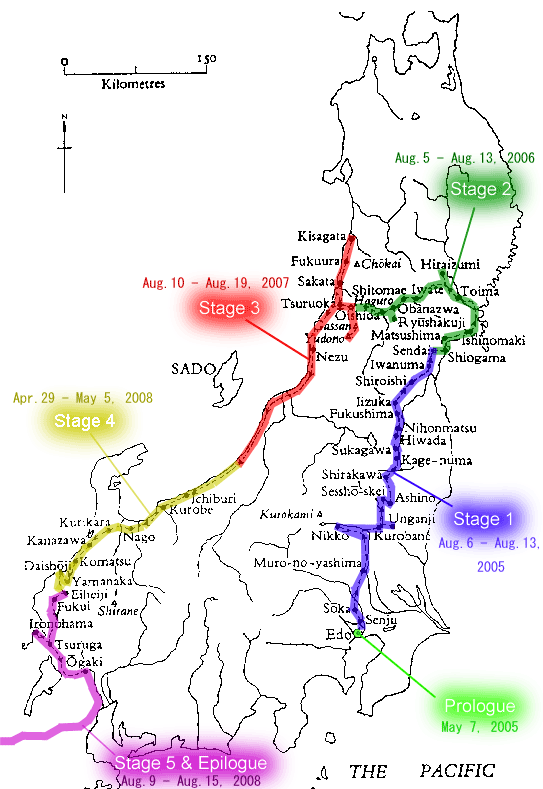
Matsuo Basho – Narrow Road Map (credit)
“The best way to discover a place, and oneself, is to walk, as Japanese haiku master Matsuo Basho set out to do in the spring of 1689. His Oku-no-hosomichi (Narrow Road to the Deep North), a travelogue in poetry and prose, charts his 2,400km journey, mostly on foot, from Edo (modern-day Tokyo) to the Tohoku region. For five months, Basho trekked from countryside to coast and forest, spending nights at temples and inns, and imbibing the simple beauty around him.” (credit)
In one of its most memorable passages, Bashō suggests that “every day is a journey, and the journey itself home.”…”Today thousands of people pilgrimage to Basho’s birthplace and burial shrine and travel parts of Bashos Trail. After three centuries his Narrow Road, in print in English and many other languages, still speaks to readers around the world.” … “
Whatever its source–Basho lived a turbulent life in a changing Japan–his melancholy was an intensifying element in much of his writing and an important part of what, in the end, propelled him on his journeys.
Few details are known about Basho’s early life, but he is thought to have been born in 1644 in the castle town of Ueno, southeast of Kyoto. His father, a minor samurai, may have earned his keep teaching children to write. Many of Basho’s siblings probably became farmers.
Basho, however, acquired a taste for literature, perhaps from the son of the local lord, whose service he joined. He learned the craft of poetry from Kigin, a prominent Kyoto poet, and early in his life was exposed to two lasting influences: Chinese poetry and the tenets of Taoism. After his master died, Basho began spending time in Kyoto, practicing a form called haikai, consisting of linked verses.
In Bashos time, the first verse in haikai was evolving into a poetic idiom of its own–haiku, whose unrhymed phrases of five, seven, and five syllables are meant to capture the essence of nature. Basho published his first haiku under various names, each having some personal significance. One, Tosei, or “green peach,” was an homage to the Chinese poet Li Po (“white plum”).
In his late 20s Basho moved to Edo (now old Tokyo), a newly established city in great social flux, with a fast-growing population, robust trade, and, for Basho, literary opportunity. Within a few years he had gathered the coterie of students and patrons who formed what came to be known as the Basho School.
In 1680 one of his students built the poet a small house near the River Sumida, and soon after, when another presented him with a stock of basho tree (a species of banana), the poet started writing under the name that has endured: Basho. Credible accounts of his life hold that during this period he was plagued with spiritual doubt and took up the study of Zen Buddhism. His despair only deepened in 1682, when his house burned to the ground in a fire that obliterated much of Edo.”… ”
In 1684 Basho made a months-long journey westward from Edo, which occasioned his first travel account, Journal of a Weather-Beaten Skeleton. In Basho’s day travel was by foot and lodging was primitive. But despite these rigors he set out again in 1687 and a third time in 1687-1688, journeys recounted in Kashima Journal and Manuscript in a Knapsack. Both were written in a genre that Basho profoundly refined–haibun, a mixture of haiku and prose. The poetic travel works and the strenuous sojourns that inspired them added luster to Basho’s reputation.
Yet in the autumn of 1688, in his mid-40s, Basho confided to friends that he still felt the world was too much with him. Exhausted from the incessant demands of students and of his literary celebrity, he said that he “felt the breezes from the afterlife cross his face.” He began planning a pilgrimage to sites important for their literary, religious, or military history–places he wanted to see before he died. He intended to leave that winter, but his friends, worried about his frail health, begged him to wait until spring. Finally, in May 1689, accompanied by his friend and disciple Sora and carrying only a backpack, writing materials, and changes of clothing, Basho set out, determined yet again to become a hyohakusha–“one who moves without direction.” He walked for five months through the uplands and lowlands, villages, and mountains north of Edo and along the shores of the Sea of Japan. It was this wonderfully episodic sojourning that produced his masterwork, Narrow Road to a Far Province. “It was as if the very soul of Japan had itself written it,” said the early 20th-century Buddhist poet Miyazawa Kenji.
The book is a spiritual journey, synonymous with taking a Buddhist path, shedding all worldly belongings and casting fate to the winds. But the physical journey had a practical side: Basho made his living in part as a teacher, and as he traveled, any number of far-flung disciples were happy to host the master and receive lessons in poetry.”… “In the intervening centuries, Basho has become many things to many people–bohemian sage, outsider artist, consummate wayfarer, beatific saint, and above all a poet for the ages. In his Narrow Road, Basho seamlessly plaits together self-deprecating humor, logistical detail, Buddhist compliance, painterly description, and even raunchy complaint (“Fleas and lice biting; / Awake all night / A horse pissing close to my ear”). At the same time, his book provides a kind of timeless spiritual map for the traveler. Helen Tanizaki once characterized Basho this way: “He’s like a quirky philosopher tour-guide who pretty much leaves readers alone to experience traveling in those remote places for themselves. Rather than trying to account for things, he just feels the obligation to take note of them, a vast striving for connection.””
Credit for above: Norman, Howard. “On the Trail of a Ghost.” National Geographic 213, no. 2 (February 2008): 136–49. //search.ebscohost.com/